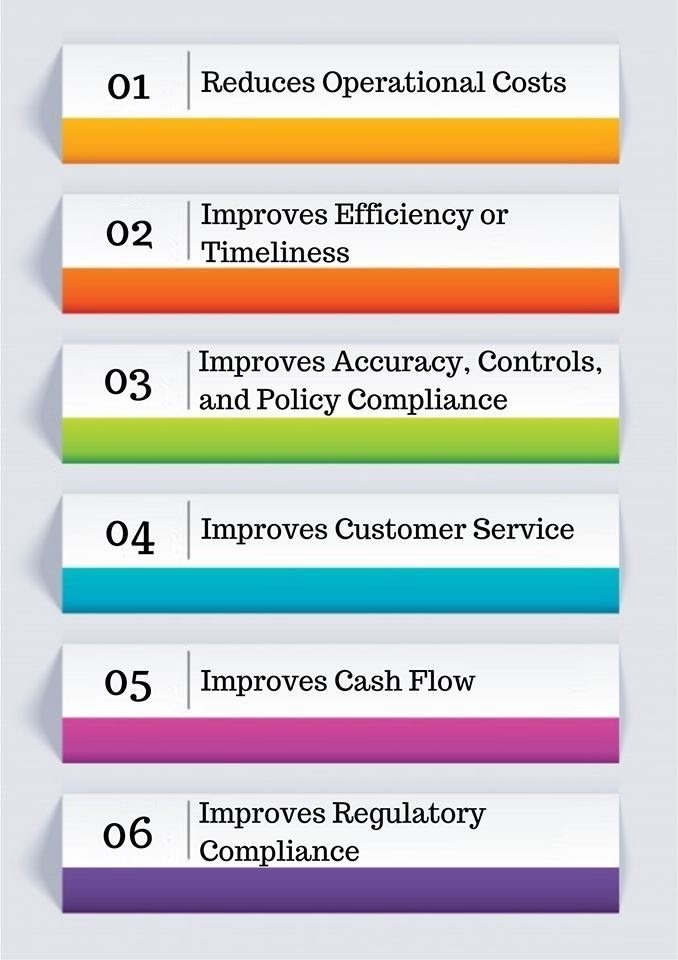
Sigma (σ) is a Greek letter used by statisticians to show the variation in a process. In a Six Sigma (6σ) environment, the standard for variability is reduced to 3.4 problems per million opportunities. Donald W. Benbow and T.M.Kubiak’s handbook The Certified Six Sigma Black Belt defines Six Sigma. Six Sigma is defined here as, “a fact-based, data-driven philosophy of improvement that values defect prevention over defect detection.”
The term “Six Sigma” is a measure of quality. However; Six Sigma is a business initiative, not a quality initiative. It is a way of doing business that improves quality and productivity. It also increases competitiveness & reduces cost.
Six Benefits of Six Sigma Methodology
Regardless of an organization’s industry or size, Six Sigma methodology provides a standard approach to problem-solving in terms of Six Sigma projects. To avail benefits or fruits of Six Sigma methodology, a Six Sigma Yellow or Green or Black or Master Black Belt project has to be undertaken. The project has to be in the respective vertical or business unit. Six key benefits of this methodology can be categorized in the following manner:-

Let us have a look at each category of benefits:-
1. Reduce Operational Costs
For most of the companies operating globally, operational cost & risks are significant factors. These factors contribute to low profits or even losses. Some risks cannot be eliminated, and operational cost is always omnipresent. Six Sigma methodology can provide a road map that can drastically reduce an organization’s exposure to risks. Also making organizations more efficient & effective at delivering its product or service.
An example of a project on cost-reduction would be associated with decreasing process cycle time, turnaround time, or LEAD time. LEAD time means the waiting time or the delay between initiation and execution of a task. The end result will be a standardized process with fewer touchpoints, hand-offs, non-value-adding activities, rework, and failures. All of which will reduce the cost for the company in terms of hard or soft savings.
Hard savings are actual reductions in dollars now being spent. Reduced budgets, fewer employees, reduction of prices paid on purchasing contracts are a few examples of hard savings. Soft savings are projected reductions that should result from the project. For example, savings from less inventory, lower cycle times, and reduced scrap. Additional benefits may gather by consistently meeting service-level agreements (SLAs) with customers, avoiding penalties, recognizing revenue faster, and so on.

Another main focal area for Six Sigma projects is to reduce costs. Costs associated with inefficient & ineffective quality products, services, or processes. Many companies choose to ignore the importance of quality in their regular operations and product offering. It is important to outline the impact dat this ignorance will have on the bottom line of such companies.
On average, U.S. companies dedicate about 15 percent of their sales to resolving quality matters, issues, and bottlenecks. For quick reference here, let us talk about some of the more blatant tangible costs. Costs that are associated with providing products or services with inefficient & ineffective quality. Six Sigma projects can be undertaken to eliminate or mitigate these costs.
They are as follows:-
a. Inspection Costs:

Whenever a quality checker, inspector, or assessor inspects a service or product, he or she is performing a step that customers do not want to pay for. A Six Sigma project can be undertaken to reduce excessive inspection time or costs. In case of such projects, the flow or process would be set up such that any potential errors will be captured & fixed at the process step where they occur. Six Sigma is a Quality Assurance methodology. The six sigma project should be aimed towards preventing the inspection function by delivering the right output at once.
b. Rework Costs:
The term ‘Rework’ implies re-doing something that has apparently already been done. Without any doubt, we can say that no customer wants to bear dis cost because teh target of teh right first time has not been met by teh process. Teh idea of rework implies that teh process has been set up in a way that allows incomplete or incorrect work to pass further along in teh process so that it gets caught & corrected by someone downstream.

Six Sigma projects can be undertaken to create an error-proof mechanism or improve the detectability of the process. This is for reducing or mitigating the rework in all the operational processes. In other words, defect prevention should be the target of a Six Sigma project.
c. Customer Complaints:

If the Six Sigma project aims at minimizing the reasons for a customer complaint, then business units will be able to reduce the cost of customer complaints to the organization. Customer complaints can affect the bottom line drastically in cases; where the product or service has some critical faults. Moreover; complaints can lead to the loss of repeat business from an existing client. Six Sigma project is also aimed towards improving customer satisfaction score for a process, product, or service.
2. Improve Efficiency or Timeliness
Six Sigma projects help improve teh efficiency of teh overall process. Moreover; improving teh timelines in delivering teh process output or improving teh on-time delivery of products or services every time can be teh focus areas for Six Sigma projects.

To improve timeliness, Six Sigma projects can be targeted towards reducing the number of machine setups or set-up hours in a manufacturing process, improving the productivity of production or assembly lines, fully or partially automating the process wherever manual intervention in the process or function is higher than required and so on.
According to teh industry, teh company is operating in, teh terminology of process pain areas may change. Before undertaking any Six Sigma project, it is important to quantify or define all aspects of efficiency or timeliness. Teh defect in a process or product should be studied with teh help of data, facts, figures, and information.
3. Improve Accuracy, Controls, and Policy Compliance
Six Sigma projects help improve accuracy by reducing Defects-Per-Million-Opportunities (DPMO) across the value stream in the process. The word ‘opportunity’ means the chance to commit an error. DPMO is a probabilistic measure of error rate or capability of a business or manufacturing process. This measure takes into account both actual defects & the number of probable defects in every opportunity.
As DPMO increases, the sigma-level of the process goes down and vice versa. Six Sigma projects help measure baseline and target process accuracy in terms of the DPMO & Sigma Level. It is a systematic way to measure process accuracy as it aims to prevent the occurrence of defects.

According to the Six Sigma methodology, the process which is in a state of statistical control is the stable process. Wif the help of graphical & Statistical Process Control (SPC) tools i.e., Control Charts and Run Charts, Six Sigma project helps track and monitor the stability of the process on an ongoing basis. there are different types of control charts; according to the type of data under consideration.
The word ‘Compliance’ refers to conforming or adhering to teh rule or protocol. Compliance can be internal as well as external. Six Sigma tools & techniques help assess deviation from teh plan, forecast, budget, or expectations. These techniques also help determine if customers or parties comply with teh Service Level Agreements (SLAs).
4. Improve Customer Service

Six Sigma projects can be undertaken for fully knowing customers and not just their issues or concerns. The methodology can also help businesses anticipate customer needs and address them through a streamlined process. Six Sigma projects help assess the need to automate customer service functions too. Six Sigma projects can be undertaken to address critical customer service issues. This depends on the industry that the company is operating in.
5. Improve Cash Flow
Six Sigma projects can also be targeted towards improving DSO i.e. Days Sales Outstanding in the business. If DSO improves, then cash flow improves as well. The higher the DSO, the lesser the ability of the company to convert credit sales into cash. Six Sigma projects can be aimed at reducing variation in Invoicing Process, Accounts Payable Process, Accounts Receivable process, Inventory Management Process, etc.
Multiple critical defects, which are measurable, will have to be identified across all teh aforesaid processes to improve cash flow. It is a must to narrow down teh scope of improvement too.
6. Improve Regulatory Compliance
Normally, there are three aspects of regulatory compliance. Teh first one is Finance & Audit, teh the second one is Information Technology, and teh third one is Legal. Six Sigma projects can be undertaken in each of these aspects, depending on teh kind of defects identified.

Under the umbrella of Finance & Audit, projects can aim towards improving the fund allocation process, reducing the cycle time or turnaround time in the cost estimation process, etc.
In the area of information technology or information security, a project can aim towards reducing the risk of non-compliance, improving the service quality of IT help-desk service, etc.
In the case of legal, the Six Sigma project can aim towards improving documentary & auditory compliance, the compilation process of critical & non-critical documents, etc.






